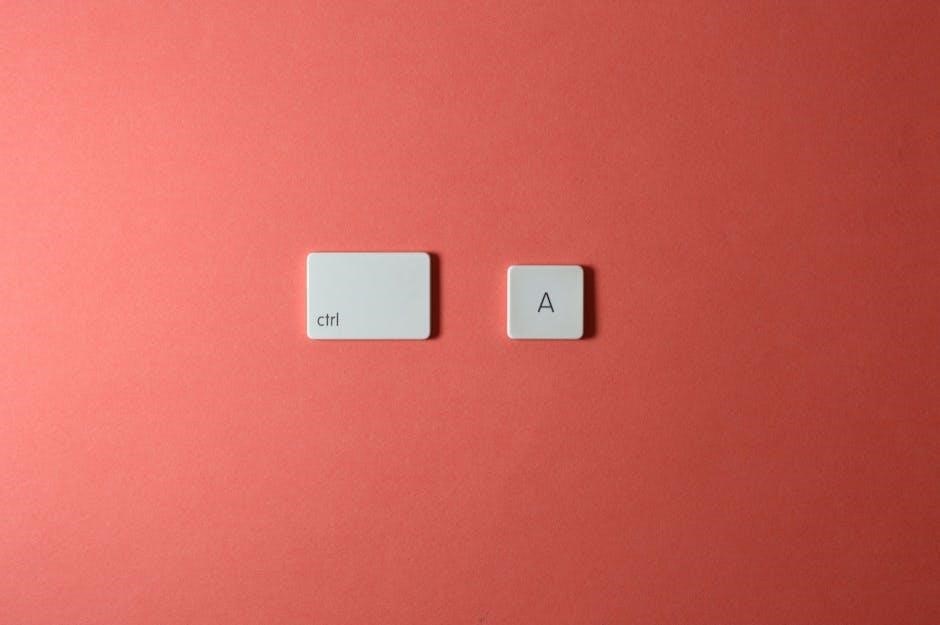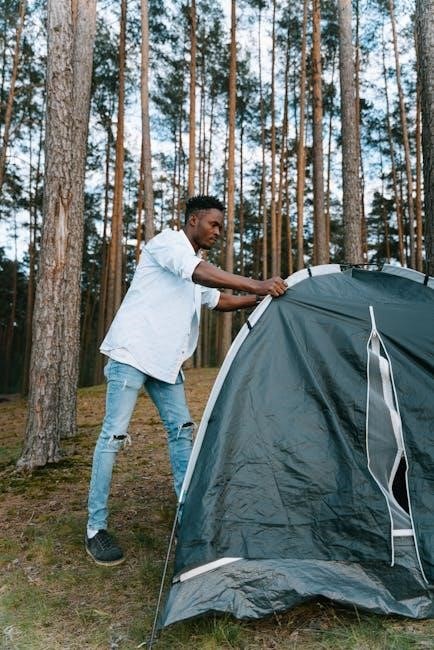Welcome to the Tent Instructions Manual! This comprehensive guide provides step-by-step instructions for setting up‚ maintaining‚ and troubleshooting your tent. Designed for both beginners and experienced campers‚ it ensures a safe and enjoyable outdoor experience. Follow these clear instructions to master the art of tent setup and care.
1;1 Purpose of the Manual
This manual serves as a detailed guide to help users successfully set up‚ maintain‚ and troubleshoot their tent. Its purpose is to provide clear‚ step-by-step instructions for ensuring a safe and efficient camping experience. Whether you’re a seasoned camper or a first-time user‚ this manual will walk you through every aspect of tent setup‚ from choosing the right location to securing the structure and addressing common issues. By following these guidelines‚ you’ll be able to optimize your tent’s performance and enjoy a hassle-free outdoor adventure.
1.2 Importance of Following Instructions
Following the instructions in this manual is crucial for ensuring the stability‚ safety‚ and longevity of your tent. Proper setup prevents structural damage and ensures weather resistance. Missteps can lead to leaks‚ uneven surfaces‚ or even collapse. By adhering to the guidelines‚ you’ll avoid common pitfalls and enjoy a secure shelter. This manual is tailored to your tent’s specific design‚ making it an essential resource for a successful camping experience. Always prioritize these instructions to maximize your tent’s performance and durability.

Pre-Setup Guide
Begin by selecting a flat‚ dry location‚ clearing debris‚ and unrolling the tent footprint. Ensure all components are accounted for before proceeding with assembly.
2.1 Choosing the Right Location
Selecting the right location is crucial for a safe and comfortable camping experience. Look for a flat‚ dry spot with good drainage to avoid water pooling. Avoid low-lying areas or spots with standing water‚ as they can be prone to flooding. Ensure the area is clear of debris‚ rocks‚ and branches that could damage the tent. Consider wind direction to minimize exposure and ensure stability. Ideal locations have soft ground‚ like grass‚ for easy staking. Always check for any overhead obstacles like trees or power lines. A well-chosen site ensures a secure and enjoyable setup.
2.2 Preparing the Site
Once the location is chosen‚ clear the area of debris‚ rocks‚ and branches to ensure a smooth setup. Lay a tarp or groundsheet to protect the tent from moisture and abrasion. If necessary‚ remove leaves or pine needles to create a dry surface. Use a shovel to level the ground and fill any holes or dips. Check for underground obstacles to prevent damage to poles or stakes. Ensure the site is firm and even‚ avoiding soft or uneven terrain. A well-prepared site guarantees better stability and prevents potential issues during setup.
2.3 Unpacking and Inventory
Begin by carefully unpacking the tent and laying out all components on a clean‚ dry surface. Check the contents against the inventory list provided in the manual to ensure no parts are missing or damaged. Organize the poles‚ stakes‚ and rain fly separately for easy access. Familiarize yourself with each item‚ such as the tent body‚ footprint‚ and guy lines. Double-check for any pre-attached components and review the instructions to understand how each part connects. A thorough inventory ensures a smooth setup process without delays or missing pieces.

Tent Setup Process
Setting up your tent begins with laying out the footprint and unfolding the tent body. Attach the poles to the corners‚ ensuring they fit securely into the sleeves. Stand the tent upright and connect the poles to the corresponding grommets; Tighten and secure the tent structure using stakes and guy lines for stability. Attach the rain fly for weather protection and ensure all components are properly aligned and tightened. This step-by-step process ensures a sturdy and weather-ready tent setup.
3.1 Laying Out the Footprint
Start by locating a flat‚ dry area for your tent. Unroll the footprint and position it evenly on the ground. Ensure the surface is free from debris‚ rocks‚ and twigs to prevent damage; Align the footprint with the direction of the wind to maximize stability. Secure the corners with temporary stakes to hold it in place. This step ensures a smooth setup and protects the tent’s floor from moisture and abrasion. A well-laid footprint is essential for a stable and durable tent structure.
3.2 Unfolding and Positioning the Tent
After laying the footprint‚ carefully unfold the tent body and position it on top‚ ensuring all corners align with the footprint edges. Smooth out any wrinkles and check that the tent is centered. Face the tent’s entrance away from prevailing winds for better stability. Use the attached straps or clips to secure the tent to the footprint‚ ensuring proper alignment. This step ensures the tent is evenly spread and ready for pole assembly. Make sure the tent fabric is not twisted or bunched up for a smooth setup process.
3.3 Assembling the Poles
Begin by sorting and organizing the tent poles according to their lengths and labels. Match each pole to its corresponding sleeve or connector on the tent. For most tents‚ poles are color-coded or labeled for easy identification. Insert one end of the pole into the metal connector or grommet‚ ensuring it clicks securely. Repeat for all poles‚ making sure each is fully seated and aligned properly. Once assembled‚ double-check that all connections are tight and the poles are straight. This step is critical for the structural integrity of the tent.

3.4 Attaching Poles to the Tent
Once the poles are assembled‚ align each pole with the corresponding connectors on the tent‚ such as grommets or sleeves. Insert the pole ends into the connectors‚ ensuring they fit securely. For most tents‚ poles snap or click into place. Attach the other end of the pole to the tent’s frame or hub‚ making sure it is fully seated. Repeat for all poles‚ ensuring each is properly attached to maintain the tent’s structural integrity. Follow the manufacturer’s instructions for specific attachment methods‚ as they may vary depending on the tent design.
3.5 Erecting the Tent Structure
With the poles attached‚ carefully lift the tent by the highest point and guide the poles into their respective slots or stands. Ensure the tent is lifted evenly to avoid damage. Once upright‚ secure all clips and hooks to the poles‚ making sure they are tightly fastened. For color-coded systems‚ match the clips to the corresponding poles for proper alignment. Double-check that the tent stands straight and stable before moving on to staking it down. This step ensures the structure is secure and ready for final adjustments.

Securing the Tent
Stake down the tent firmly‚ ensuring all corners are anchored. Tighten guy lines evenly to maintain structural integrity and prevent sagging. Check all connections for stability.
4.1 Staking Down the Tent
Staking down the tent is crucial for stability. Choose firm ground and drive stakes at a 45-degree angle‚ securing each corner tightly. Ensure all guy lines are taut and evenly tightened to prevent sagging. Use high-quality stakes and check the ground for rocks or roots to avoid damage. For added security‚ reinforce each stake with a mallet and double-check the tension after setup. Proper staking ensures your tent remains stable in windy conditions and protects against weather elements effectively.
4.2 Tightening Guy Lines
After securing the tent‚ tighten the guy lines to ensure the structure is taut and evenly balanced. Pull the rain fly over the tent‚ aligning the narrow diagonal top seam with the tent’s top pole. Attach the guy lines to the hooks and tighten them one by one‚ working your way around the tent. Make sure the lines are snug but not overly tight‚ as this could cause stress on the fabric. Check each line for proper tension and adjust as needed to maintain stability and prevent sagging‚ especially in windy conditions.
4.3 Ensuring Proper Tension
After securing the tent‚ check each component for proper tension. Adjust the guy lines and stakes to ensure the tent is evenly balanced and the fabric is tight. Avoid over-tightening‚ as this can stress the material. Inspect all connections and lines to confirm they are snug and secure. Proper tension ensures the tent remains stable in windy conditions and prevents sagging. Double-check the rain fly and door closures for tightness. Once everything is secure‚ your tent will be ready to withstand various weather conditions and provide a comfortable shelter.

Additional Features
This section covers advanced tent features‚ such as attaching rain flies‚ installing ventilation systems‚ and setting up doors and entrances for enhanced functionality and comfort during use.
5.1 Attaching the Rain Fly
To attach the rain fly‚ start by draping it over the tent‚ ensuring the narrow diagonal top seam aligns with the tent’s top pole. Close all fly zippers before securing it to the poles to prevent issues. Use the provided clips or hooks to fasten the fly to the tent‚ ensuring a snug fit. Check for proper alignment and tighten any loose connections. This step is crucial for weatherproofing and maintaining the tent’s structural integrity during rain or wind. Proper attachment ensures water runs off efficiently and prevents leaks.
5.2 Installing Ventilation and Windows
Ensure proper ventilation by opening the tent’s vents and windows according to the manufacturer’s instructions. Align the window panels with the tent’s frame and secure them using Velcro‚ zippers‚ or buckles. Verify that all ventilation points are unobstructed for optimal airflow. For mesh windows‚ ensure they are tightly fastened to prevent insects from entering. Adjust the windows to balance visibility and privacy. Proper installation enhances airflow‚ reduces condensation‚ and improves overall comfort inside the tent. Always check for secure closure to maintain weather resistance and structural stability.
5.3 Setting Up Doors and Entrances
Start by locating all door components‚ including zippers‚ hooks‚ and tiebacks. Attach the doors to the tent frame by aligning the hooks with the designated loops. Secure the doors using zippers or Velcro‚ ensuring a tight fit. Adjust the doors to hang evenly and close smoothly. Use tiebacks to keep doors open for ventilation or easy access. Ensure all zippers are fully closed for weather protection. Check door alignment to prevent gaps and maintain structural integrity. Follow the manufacturer’s instructions for specific door setup details.

Final Checks and Adjustments
Inspect the tent for stability‚ ensure all stakes are secure‚ and verify weather readiness. Tighten any loose connections and double-check all components for proper alignment and function.
6.1 Inspecting the Tent for Stability
After setting up your tent‚ perform a thorough inspection to ensure stability. Check that all stakes are firmly secured‚ guy lines are tightly fastened‚ and poles are fully seated. Verify that the tent fabric is taut and evenly spread to prevent sagging. Inspect all connections and joints for tightness. Ensure the rain fly is properly attached and aligned. Walk around the tent to confirm it stands upright without wobbling. Address any loose or damaged components immediately to maintain structural integrity and ensure safety‚ especially in windy or rainy conditions.
6.2 Ensuring Weather Readiness
Before finalizing your tent setup‚ ensure it is prepared for various weather conditions. Check the rain fly for proper attachment and alignment‚ ensuring it covers the tent fully. Verify that all zippers and windows are securely closed to prevent water ingress. Inspect the tent’s waterproof coating and seams for integrity. Tighten guy lines and stakes to withstand wind pressure. Ensure all fabric is taut and evenly spread to avoid sagging under rain or snow. Double-check the tent’s stability and weatherproof features to ensure it can endure harsh conditions safely.
6.3 Final Tightening of All Components
Once the tent is fully erected‚ perform a final check to ensure all components are securely tightened. Start by examining the poles‚ ensuring they are fully locked and standing straight. Tighten any loose connections between poles and the tent body. Check guy lines and stakes‚ making sure they are firmly anchored into the ground. Re-tighten all straps and buckles to maintain even tension across the tent. This step ensures maximum stability and prevents structural issues‚ especially in windy or rainy conditions. Proper tension guarantees a sturdy and reliable shelter.

Maintenance and Storage
Maintaining your tent’s condition requires regular cleaning‚ inspections‚ and proper storage. Always fold and store it in a dry place to prevent damage. Check for wear and tear to ensure longevity.
7.1 Cleaning the Tent
Cleaning your tent is essential for maintaining its durability and appearance. Start by brushing off dirt and debris. Use mild soap and water for stains‚ avoiding harsh chemicals that may damage the fabric. For tougher spots‚ gently scrub with a soft-bristle brush. Rinse thoroughly and allow the tent to air dry completely before storing. Regular cleaning prevents mold and mildew‚ ensuring your tent stays in great condition for future adventures.

7.2 Drying the Tent Before Storage
Properly drying your tent before storage is crucial to prevent mold and mildew. Lay the tent flat in a shaded‚ well-ventilated area‚ avoiding direct sunlight‚ which can damage the fabric. Ensure all surfaces‚ including the rain fly and groundsheet‚ are completely dry. If necessary‚ use a clean towel to blot excess moisture. Never store the tent damp‚ as this can lead to unpleasant odors and damage. Once dry‚ fold and store it in a cool‚ dry place to maintain its condition for future use;
7.3 Proper Storage Techniques
Store your tent in a cool‚ dry place away from direct sunlight. Use the original storage bag or a breathable fabric bag to maintain airflow. Avoid basements or attics‚ as humidity and pests can damage the tent. Ensure the tent is completely dry and free of dirt or debris before storage. Never fold or roll the tent when damp‚ as this can cause mildew. Check for pests and clean the tent thoroughly before storing. Proper storage extends the tent’s lifespan and ensures it remains in excellent condition for future adventures.

Troubleshooting Common Issues
Identify and address common tent issues like leaks‚ broken poles‚ or loose connections. Inspect for damage‚ tighten hardware‚ and apply repairs as needed for optimal performance.
8.1 Dealing with Leaks
Leaks can occur due to seam wear‚ zipper gaps‚ or fabric tears. Inspect the tent for water entry points and apply seam sealant to vulnerable areas. Ensure the rain fly is properly attached and zippers are fully closed. For minor tears‚ use a fabric repair kit. After each use‚ dry the tent thoroughly to prevent mildew. Regularly inspect and maintain the tent’s water-resistant coating to enhance its weatherproofing capabilities. Addressing leaks promptly ensures a dry and comfortable camping experience.
8.2 Repairing Damaged Poles
Damaged tent poles can compromise the tent’s structural integrity. Start by identifying the break or bend in the pole. Use a pole repair sleeve or ferrule to reinforce the damaged section. Apply epoxy or adhesive to secure the sleeve in place. For minor bends‚ gently straighten the pole using a mallet or similar tool. If the damage is severe‚ replace the pole entirely. Always carry a repair kit with spare parts during camping trips to address such issues promptly and ensure the tent remains stable and secure.
8.3 Addressing Loose Connections
Loose connections can weaken your tent’s structure and stability. Inspect all pole-to-hub and pole-to-tent attachments regularly. Tighten any loose bolts‚ screws‚ or clips using an Allen wrench or similar tool. If a connection is overly worn‚ replace the affected part immediately. Ensure all joints and hinges are secure before erecting the tent. For recurring issues‚ apply a small amount of silicone spray or lubricant to moving parts. Always double-check connections after setup and after exposure to strong winds to maintain the tent’s integrity and safety.
By following this comprehensive guide‚ you’ve successfully navigated the process of setting up‚ securing‚ and maintaining your tent. Proper setup and regular maintenance ensure safety and longevity. Remember to double-check all connections and tighten components after use. Camping is an incredible way to connect with nature‚ and a well-prepared tent enhances your experience. Always store your tent correctly and address any issues promptly. Happy camping‚ and enjoy the great outdoors with confidence in your shelter!
